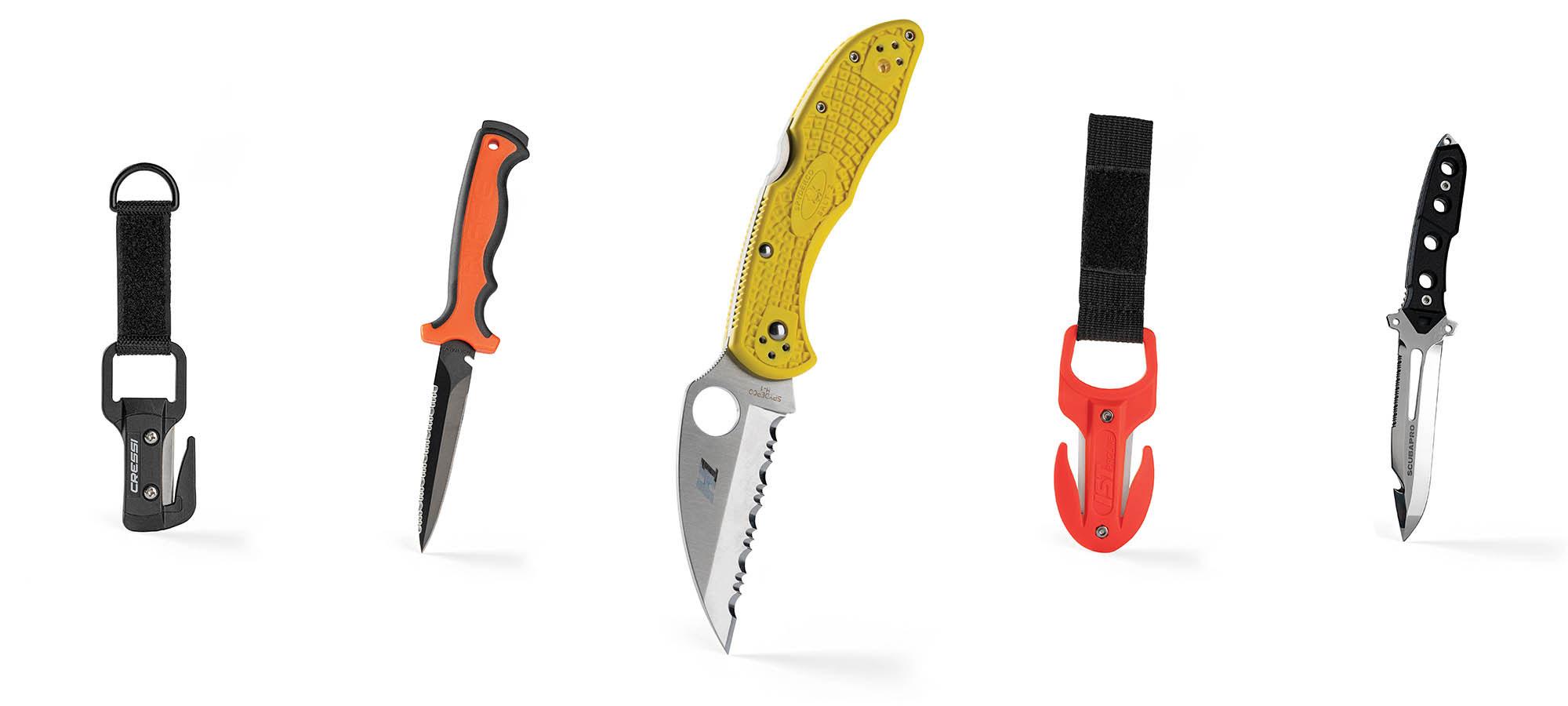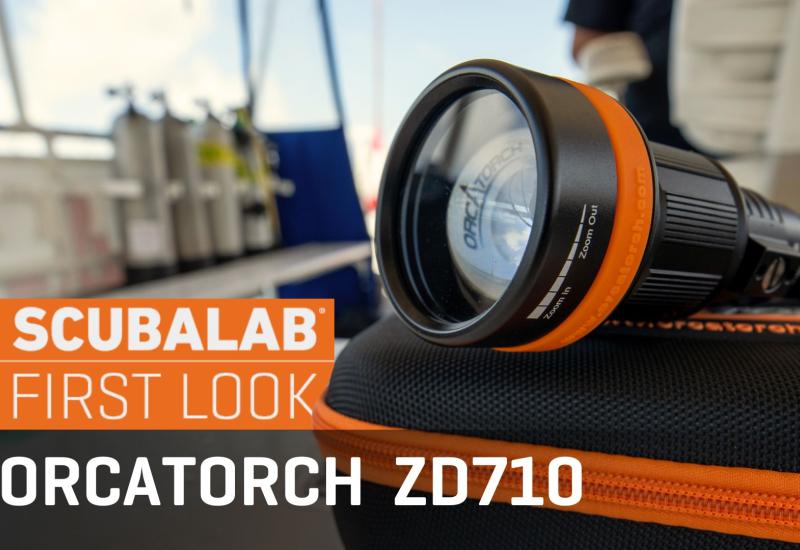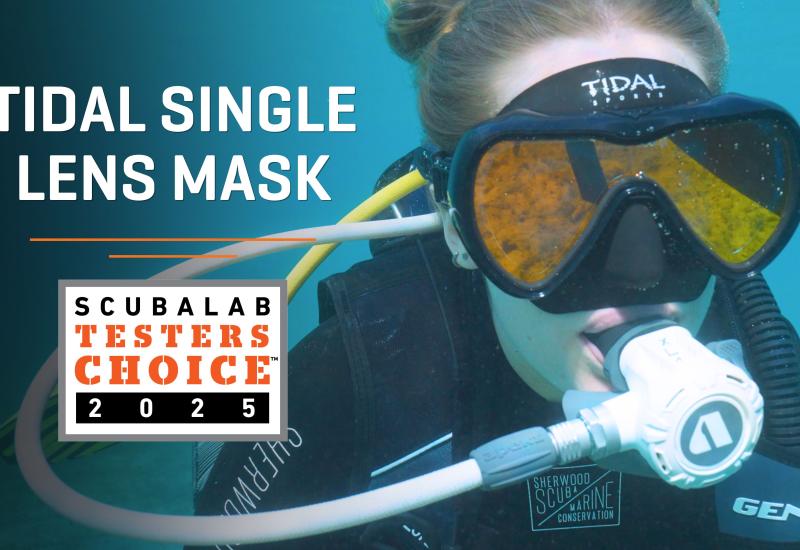15 Brand-New Dive Knives Tested By ScubaLab
You want a dive knife that is sharp, strong and resistant to corrosion. We tested 15 brand-new knives and cutting tools to find out which ones have the edge.
HOW WE TEST
Our test was designed to gauge each knife’s cutting ability, ergonomics and suitability for dive use, and its durability and corrosion resistance.
Cutting Ability
We gauged the ability to cut through handheld loops of 4 materials: heavy duty (.095-inch) plastic trimmer line; 1⁄4-inch hollow polypropylene; 3⁄8 manila; and 1⁄2-inch three- strand twisted polypropylene. We chose these because they’re typical of the materials in the lines and nets encountered by divers.
If a knife could cut a line in a single pass, a double thickness was attempted. After all four lines were cut, the knife was used to make 20 repetitive cuts. Then the four cuts were attempted again to gauge whether the blade had lost any of its edge.
Ergonomics
Knives were scored for performance of their grips, sheaths, and locking mechanism, including:
- Security of sheath or folding lock
- Ease of removing and replacing from sheath (with and without gloves)
- Security/comfort of grip when cutting
- Feel, fit and finish of the knife
Durability
These tests were designed to determine a knife’s resistance to breaking or rusting.
Pry test: The blade was inserted 1 inch into a block of wood and a 10-pound weight was hung from the end of the handle to gauge its strength.
Corrosion resistance: This was intended to replicate a day of diving followed by gear maintenance, as well as situations where rinsing gear might be delayed. Knives were submerged in salt water for six hours, then rinsed in fresh water, disassembled where possible and dried.
Next the knives were submerged and left in saltwater for 24 hours, then rinsed, disassembled and dried. After each submersion, knives were carefully inspected for corrosion.
HOW WE SCORE
Cuts were scored as follows:
5 = Very easy to cut in one pass
4 = Easy to cut in one pass
3 = Possible to cut in one pass
2 = Required multiple passes to cut
1 = Very difficult to cut
Click here to download the full test scores in all categories.
The knives were also used to cut materials including multistrand copper electrical cord and heavy nylon zip ties in order to gauge each knife’s strength and ability to withstand abuse.
SPYDERCO SALT 2 WHARNCLIFFE
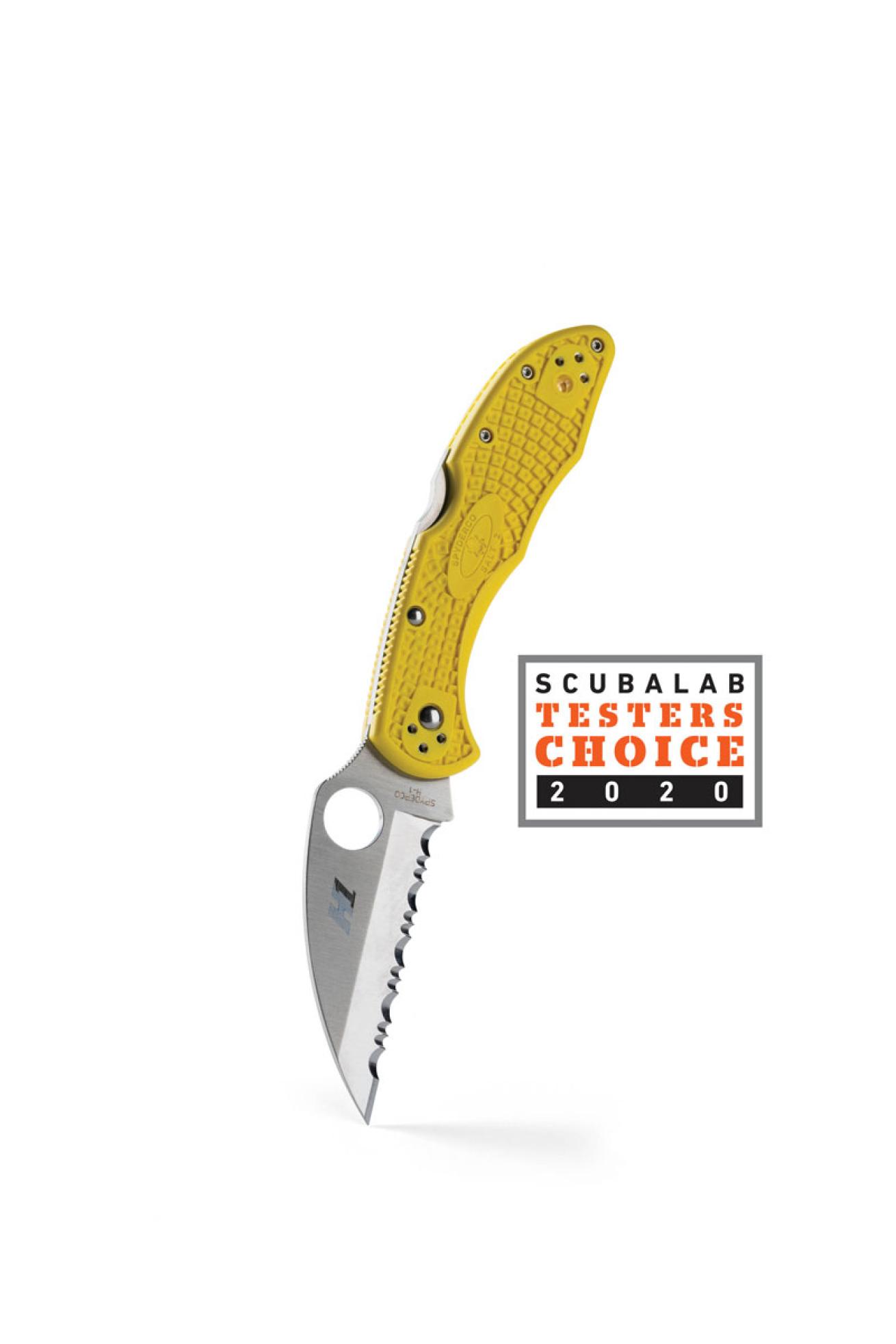
Jon WhittleMSRP $131 CONTACT spyderco.com
While it features a new Wharncliffe-style blade (about which, more in a moment), this latest member of the Salt 2 line has all the familiar attributes of Spyderco marine models. The blade is made of H1 steel, which we’ve been unable to corrode in salt water despite our determined efforts. The fiberglass-reinforced nylon handle is tough, comfortable and secure to grip, and the lock mechanism is rock-solid. As for that blade, the Wharncliffe design has a thick, curved back to support the full length of its straight 2.9-inch hollow-ground serrated edge (the Salt 2 is also available with a plain edge). The blade proved to be, as one tester noted, “an eager cutter,” taking excellent cutting scores across the board and hold- ing its edge well. “Cuts 1⁄2-inch line like green beans,” noted another tester. Just 4 inches long when folded, the Salt 2 is easy to carry and simple to open one-handed (the wide blade back allows for a generous thumbhole and seems to add some leverage). Capable, durable and nearly indestructible, the Salt 2 Wharncliffe is our Testers Choice for knives.
AKONA EDGE
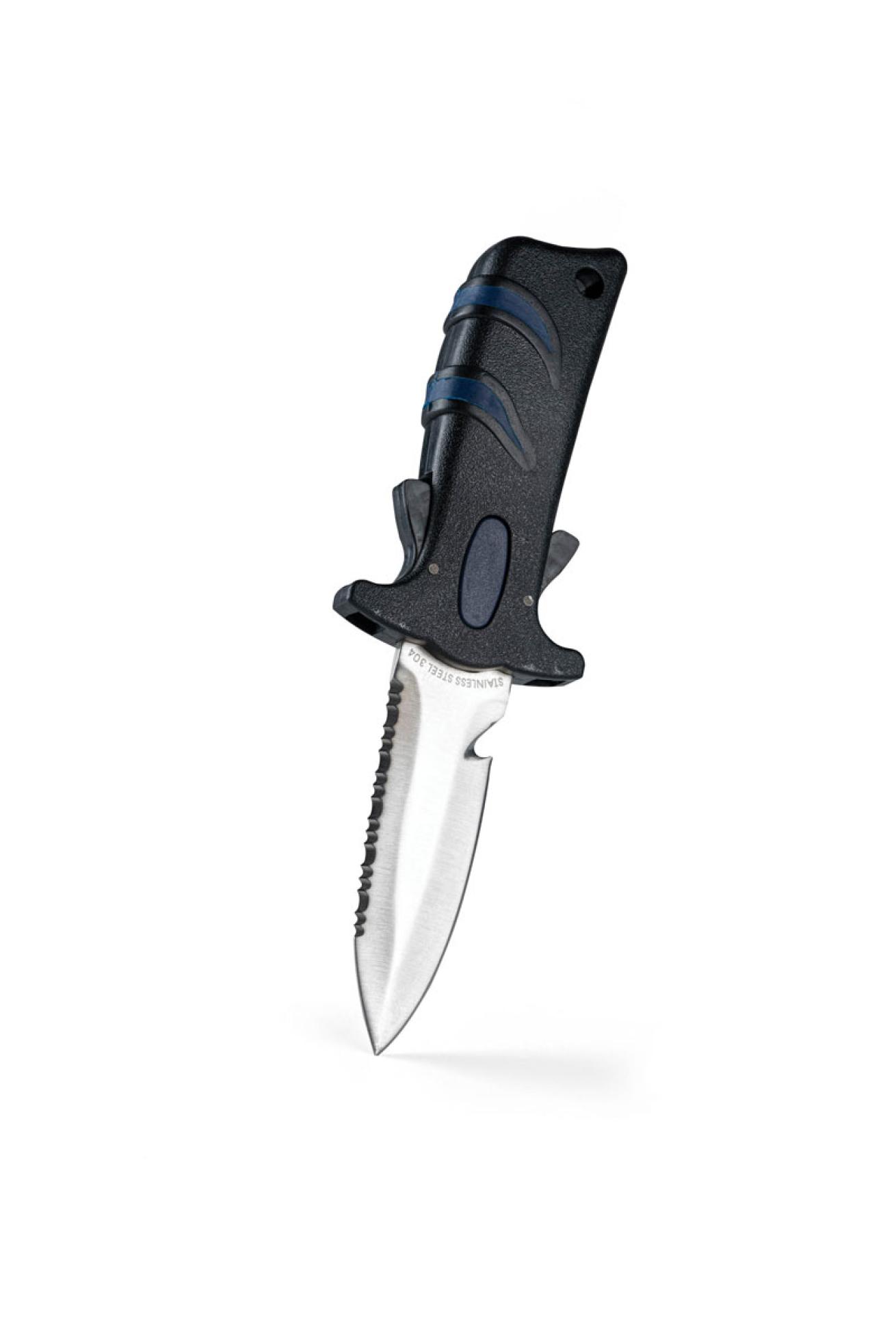
Jon WhittleMSRP $40 CONTACT akona.com
The short handle on the Edge may not leave ham-fisted divers with much to work with. But the ergonomic design offers a solid grip, and the knife's compact size makes it easy to keep handy for emergencies. Testers scored the sheath excellent for security. "No way to get it out without squeezing the release tabs," one tester observed. "Doesn't even rattle," another diver commented. The Edge also earned good scores for ease of getting it in and out of sheath. The squeeze lock is easy to operate (though slightly less so with gloves), and the knife returns to the sheath with a reassuring click. The 3-inch blade doesn't offer up a lot of cutting power, but the serrated edge allowed it to power through most test lines with enough effort. The 304 stainless held up well in our corrosion test, though some salt buildup was visible where the blade meets the handle. The Edge is stout and capable of prying hard. "Could pry an oyster shell apart with this," one tester noted.
ATOMIC AQUATICS TI-6
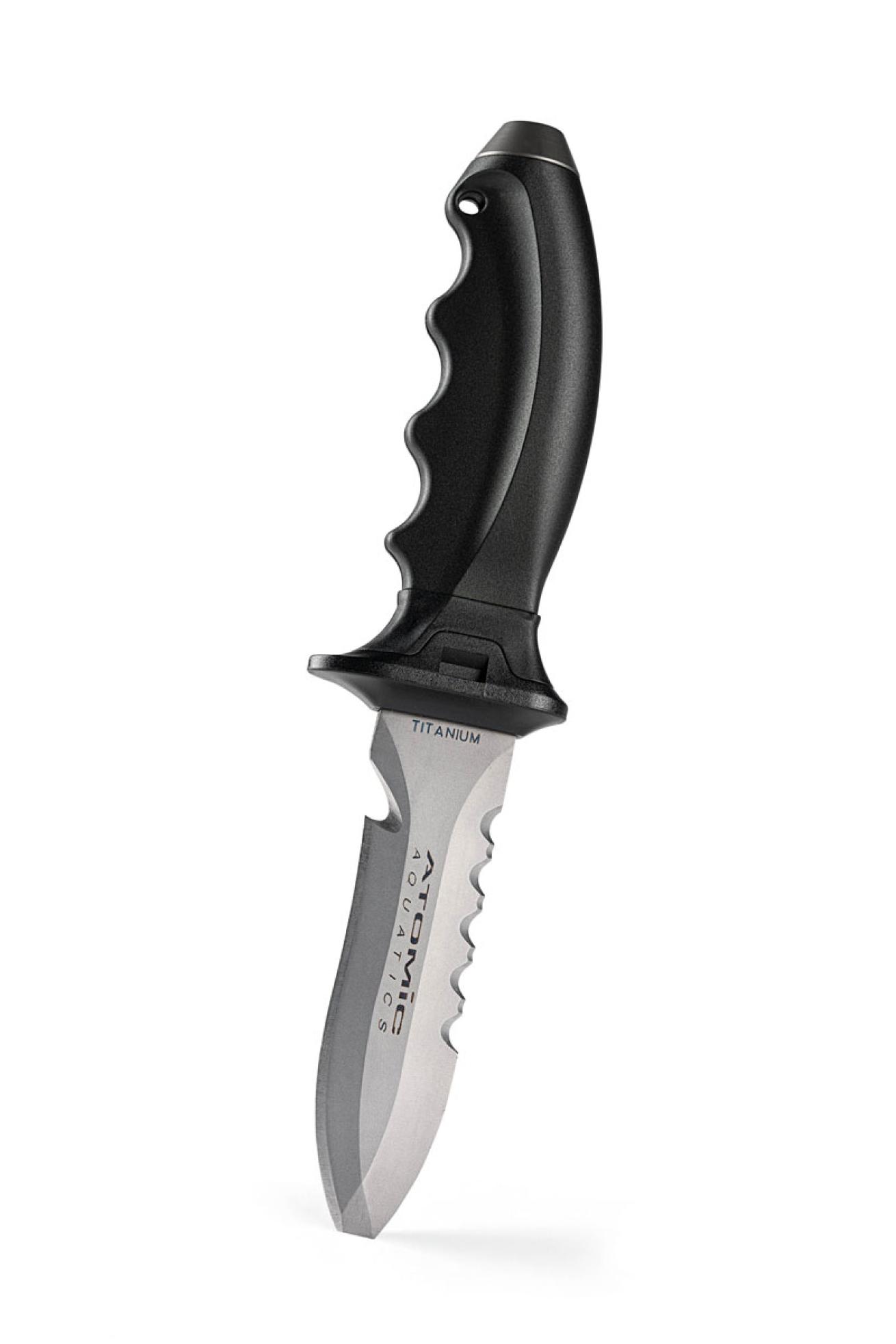
Jon WhittleMSRP $129.95 CONTACT atomicaquatics.com
Though a generous 4 inches long, the smooth edge of the titanium blade on the Ti-6 is cut short by the line cutter, and the deep notches on the serrated edge tend to get hung up on smaller line. Testers still scored the Ti-6 very good for cutting through our hollow poly test line, and good for its ability to get through manila test rope. The blade and full tang are made from a single piece of corrosion-resistant titanium, which can be removed from the grip by unscrewing the end piece. The Ti-6 is strong and springy, and pries readily. “Tough stuff,” one diver commented. The lightweight sheath locks easily and was rated excellent for security. “Rattles a bit,” one test diver observed, “but it won’t fall out.” The knife is easy to remove and replace, even with gloves. The molded handle features finger grooves for a secure grip, but they only help when cutting with the knife’s straight edge. The knife is nicely made, and maintains a nice heft despite the lightweight materials.
IST SPORTS K21
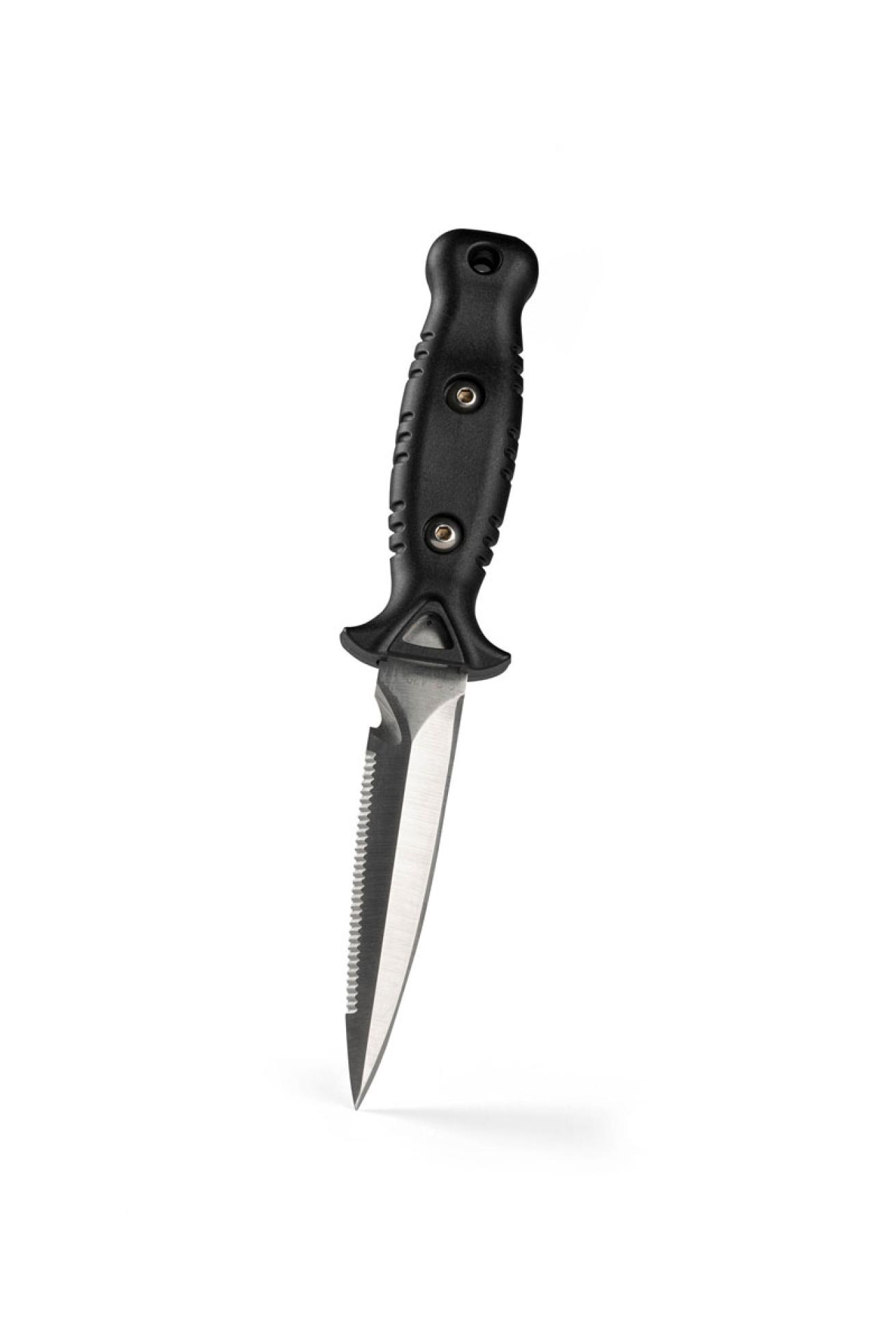
Jon WhittleMSRP $65 CONTACT istdivingsystem.com
Spearos will appreciate this daggerlike knife for its ability to quickly dispatch a struggling fish. But for general dive duty, its sharp but thick blade is less than ideal. Try as they might, testers struggled to cut through test lines with the full-length smooth edge and often resorted to sawing with the serrated side. “Like trying to carve meat with a screwdriver,” one tester lamented. But the 4¼-inch blade is strong, and held up well to our prying test. “Springy, but doesn’t bend,” in the words of one tester. Testers liked the K21’s contoured handle, which provides a comfortable rounded grip that doesn’t dig into the palm during hard cuts—although they did find that the hard, slippery material made it difficult to wield while wearing gloves. Testers rated the sheath excellent for security. “Won’t fall out. Even if you pound it,” was how one tester described it. The sheath also features an easy- to-use quick-release tab that makes it easy to deploy the knife, even one-handed.
RIFFE WRANGLER
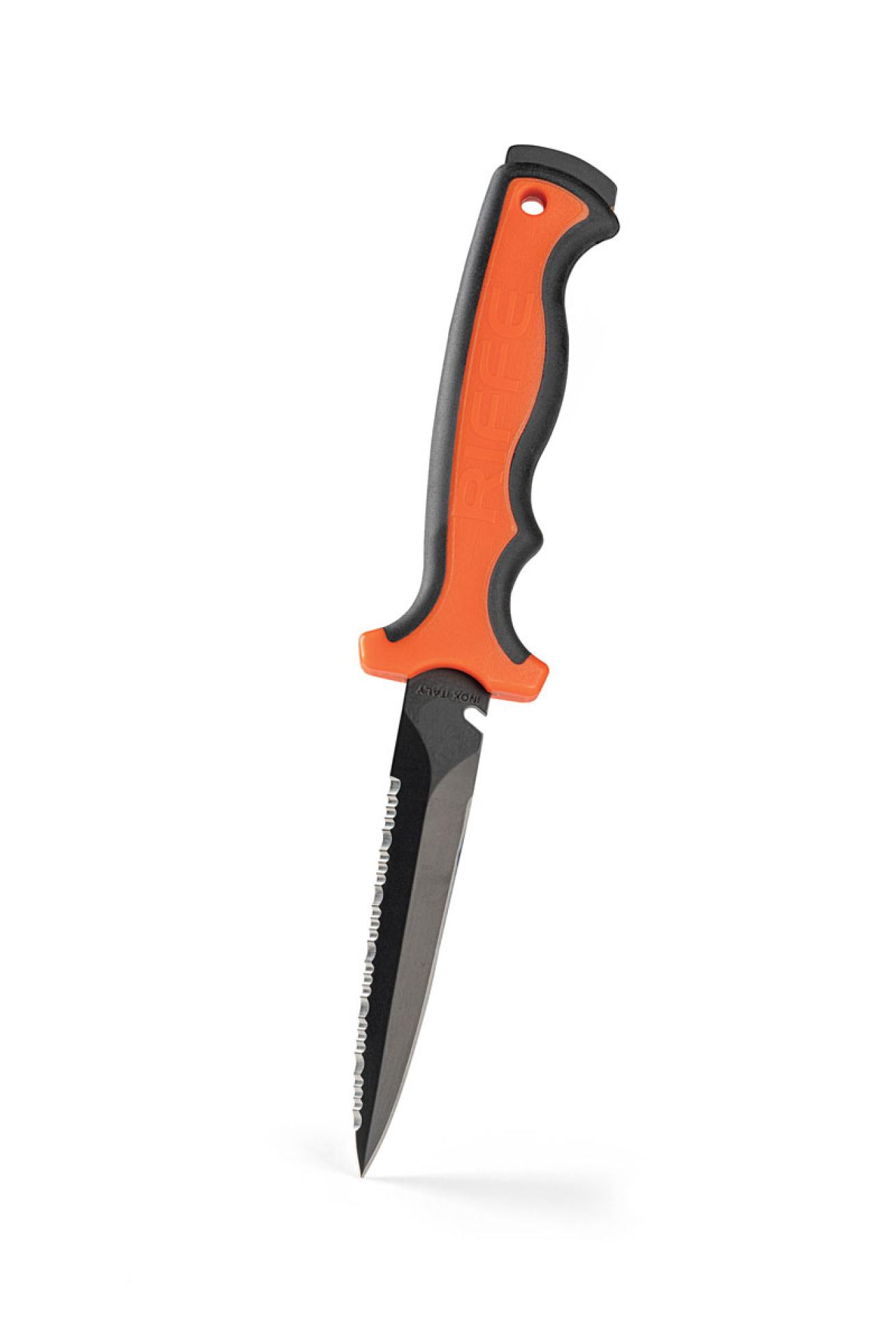
Jon WhittleMSRP $86 CONTACT riffeinternational.com
The bold black-and-orange handle of the Wrangler looks like it came out of a jack-o’-lantern carving set. But testers were impressed with the handle’s ergonomics and grippy coating. “With or without gloves, rubbery part of handle grips like glue,” one tester said. The sheath scored excellent for ease of removing/replacing thanks to the smooth-as-silk friction lock that lets you draw the blade in an instant (though it was only ranked good for security, as the knife can be released accidentally with vigorous shaking). Replacing the knife is just as effortless. “Self-guides right back in,” one tester commented. Though best suited for spearfishing, the blade earned good scores for cutting through all of our test line, with testers preferring the serrated edge. We found that the thin long blade can be bent with heavy prying, but won’t break. A Teflon coating increases corrosion resistance, but rust can still form along the edges of the stainless blade without proper care.
SCUBAPRO TK15
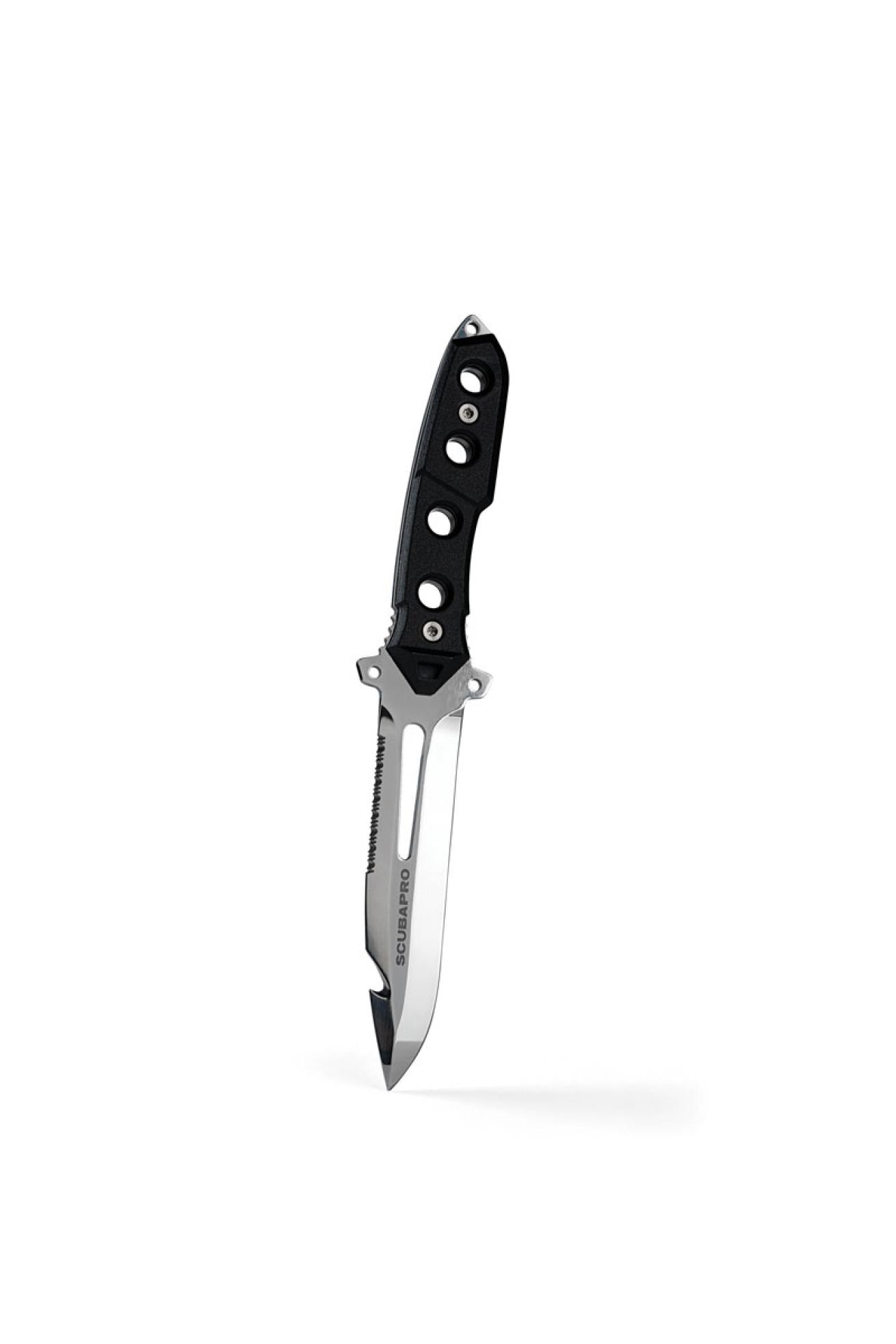
Jon WhittleMSRP $259 CONTACT scubapro.com
Crafted of a single piece of marine-grade stainless with a shiny chrome finish, the TK15 is sure to turn heads. The 6-inch blade has a full-length smooth edge and a set of serrated teeth. Both are eager to cut, earning very good scores on monofilament, hollow poly and manila test lines. Almost 4 mm thick, the blade is strong enough to pry hard. The handle can be a bit slippery with gloves, but an included hand strap offers additional security. “Great heft and feel,” one diver commented. Simply pulling the handle outward releases the knife from the reinforced fiberglass sheath. “Easy to remove, but doesn’t really lock,” one diver commented. Though a capable cutter, the thought of using the large blade on line wrapped around sensitive areas made testers a little uneasy. “The serrated edge is ready to bite you if you’re not careful,” one cautioned. The handle comes apart for thorough cleaning—a must to preserve the blade’s glossy finish.
SEAC TITANIUM KNIFE
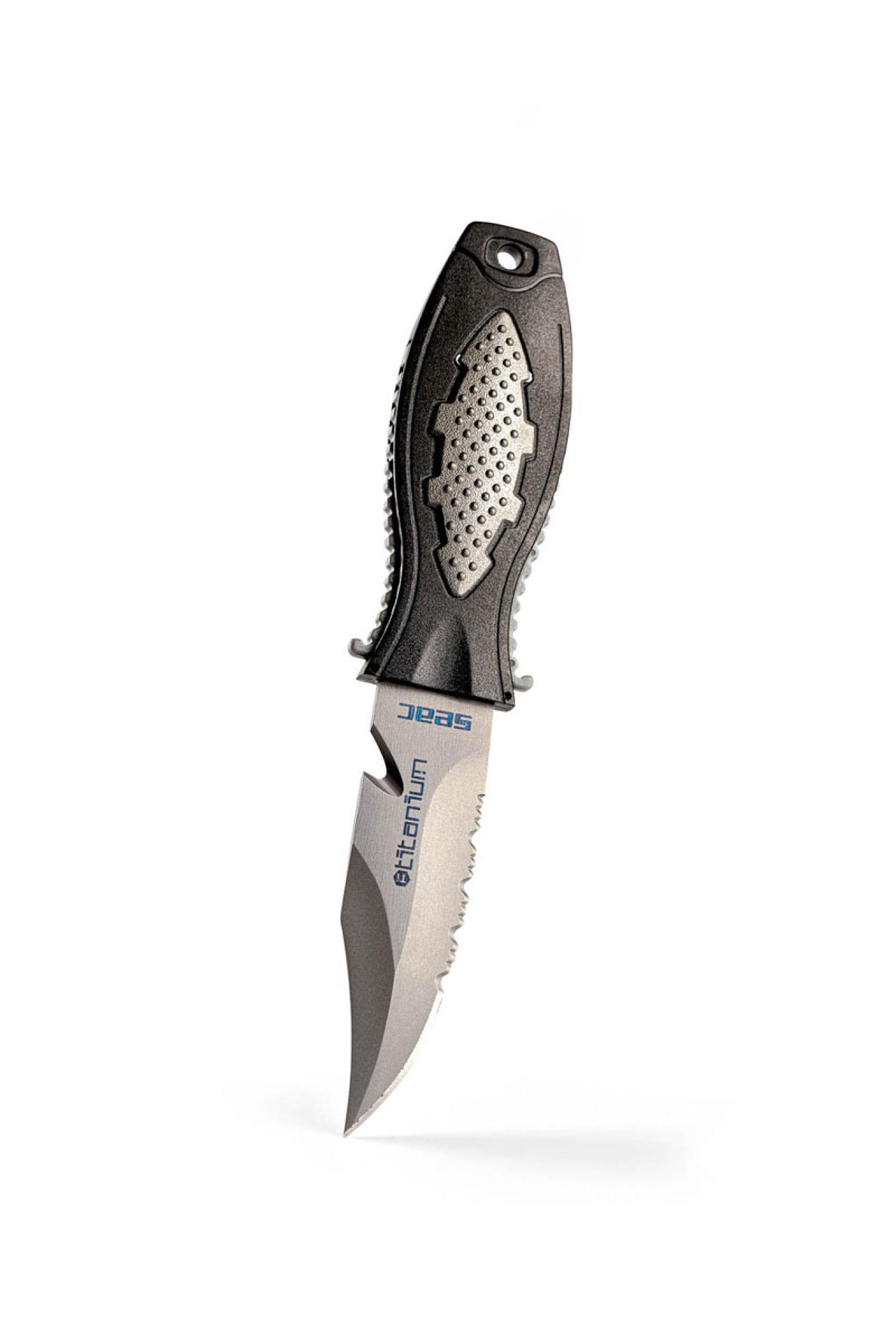
Jon WhittleMSRP $99 CONTACT seacsub.com
Lightweight construction and a wicked-looking clip-point blade make this titanium knife adept for spearfishing use. But for the diver who slices through more ropes than fish, this knife just doesn’t cut it. The smooth edge of the blade, which is given only a fraction of the 3¾-inch real estate, is placed on the curved edge, letting it slide off tough line without cutting. That means any real cutting must be done with the deeply serrated edge, which can get hung up easily while cutting tough line. A handy squeeze lock built into the handle helped the sheath score excellent for security. “Super secure. Not even a rattle,” one test diver noted. Surprisingly ergonomic for its size, the handle was rated good for security of its grip. “Nice and rounded,” another said. But its hard-plastic construction combined with the springy titanium blade isn’t meant for heavy prying. Easy to maintain and quick to deploy, the knife boasts a fierce predatory edge for underwater hunters.
SPYDERCO WATERWAY
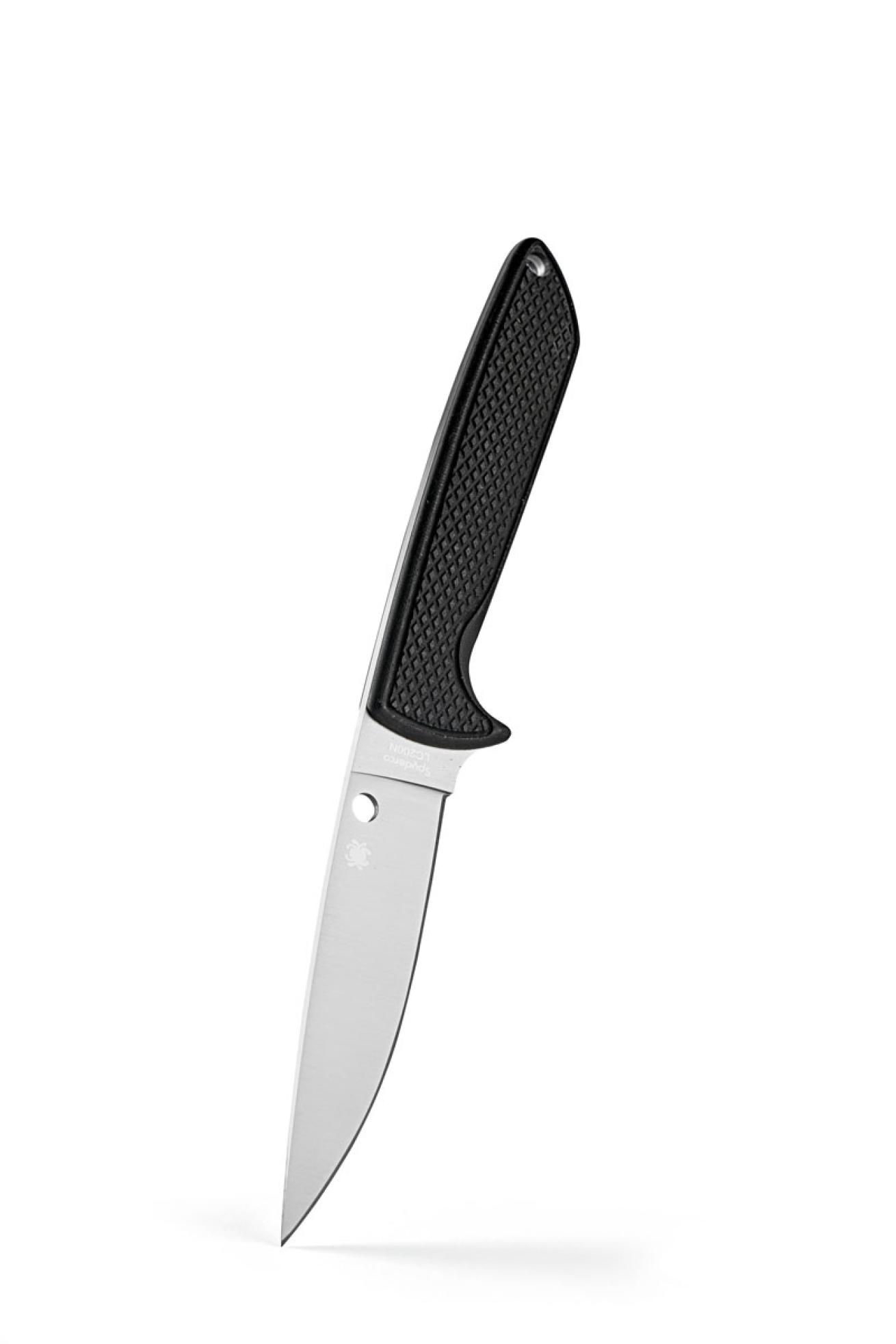
Jon WhittleMSRP $225 CONTACT spyderco.com
Made of high-nitrogen alloyed steel, the Waterway is corrosion-resistant and super sharp. Though designed primarily for fishing tasks, it’s versatile enough for general dive duty. A single plain edge runs uninterrupted along the 4½-inch-long blade; heavy monofilament, soft fibrous rope and thick strands of twisted poly hardly even slow it down. It earned excellent and very good scores in all our cutting categories. The long, thin handle has a 3D-printed nonslip pattern for a grip that sticks “like glue,” as one tester described it. Dive knife sheaths often feel like an afterthought. Not so with the Waterway, whose molded sheath matches the blade’s high-quality feel. The knife fits like a glove and draws smoothly with a sharp tug. Upon sheathing the knife, a satisfying click con- firms the blade is securely in place. “Love the sheath. Knife goes in easy and stays put,” one diver said. In the words of one of our testers, this cutter is “simple, elegant and effective.”
LINE CUTTERS
AKONA LINE CUTTER
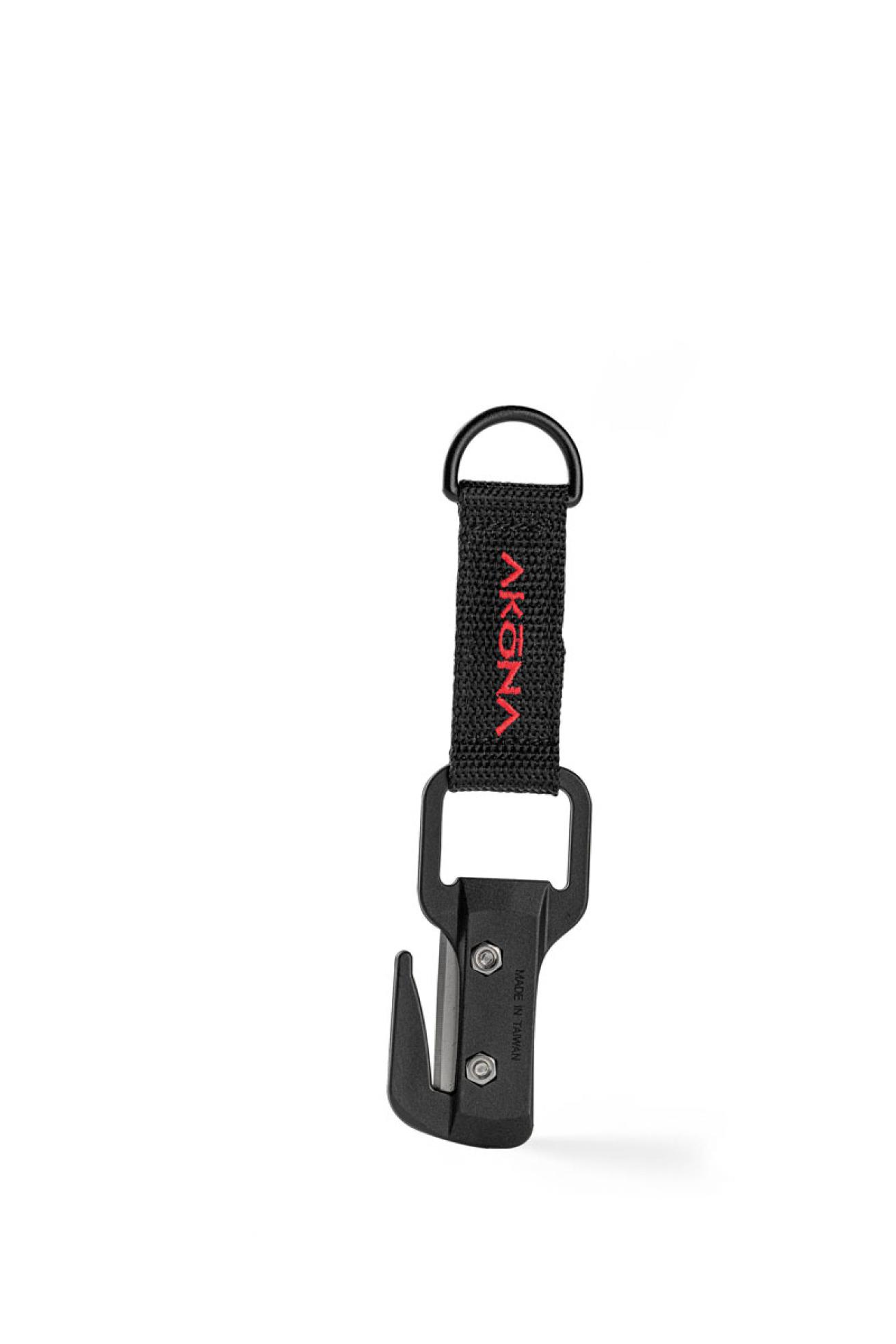
Jon WhittleMSRP $29 CONTACT akona.com
Armed with a replaceable stainless-steel razor blade, this cutter powered through all but the thickest of our test line, earning excellent and very good scores for cutting monofilament, hollow poly and manila line. “Cuts great if you can fit the line through the opening,” one tester commented after trying to work the twisted poly through the cutter’s tiny jaws. The design makes this tool great for dealing with entanglements, as it can safely get right up to the skin for close cuts. When the blade dulls—or, more likely, rusts—it can easily be replaced by removing the screws and opening the casing. The included sheath can be mounted vertically or horizontally for easy access, and its hook-and-loop closure was rated very good for security. The small nylon strap doesn’t provide much to hold on to while cutting, but the tool cuts so readily that this lack of leverage isn’t much of a concern. Lightweight and unobtrusive, this is a handy tool to keep with you on every dive.
CRESSI LINE CUTTER
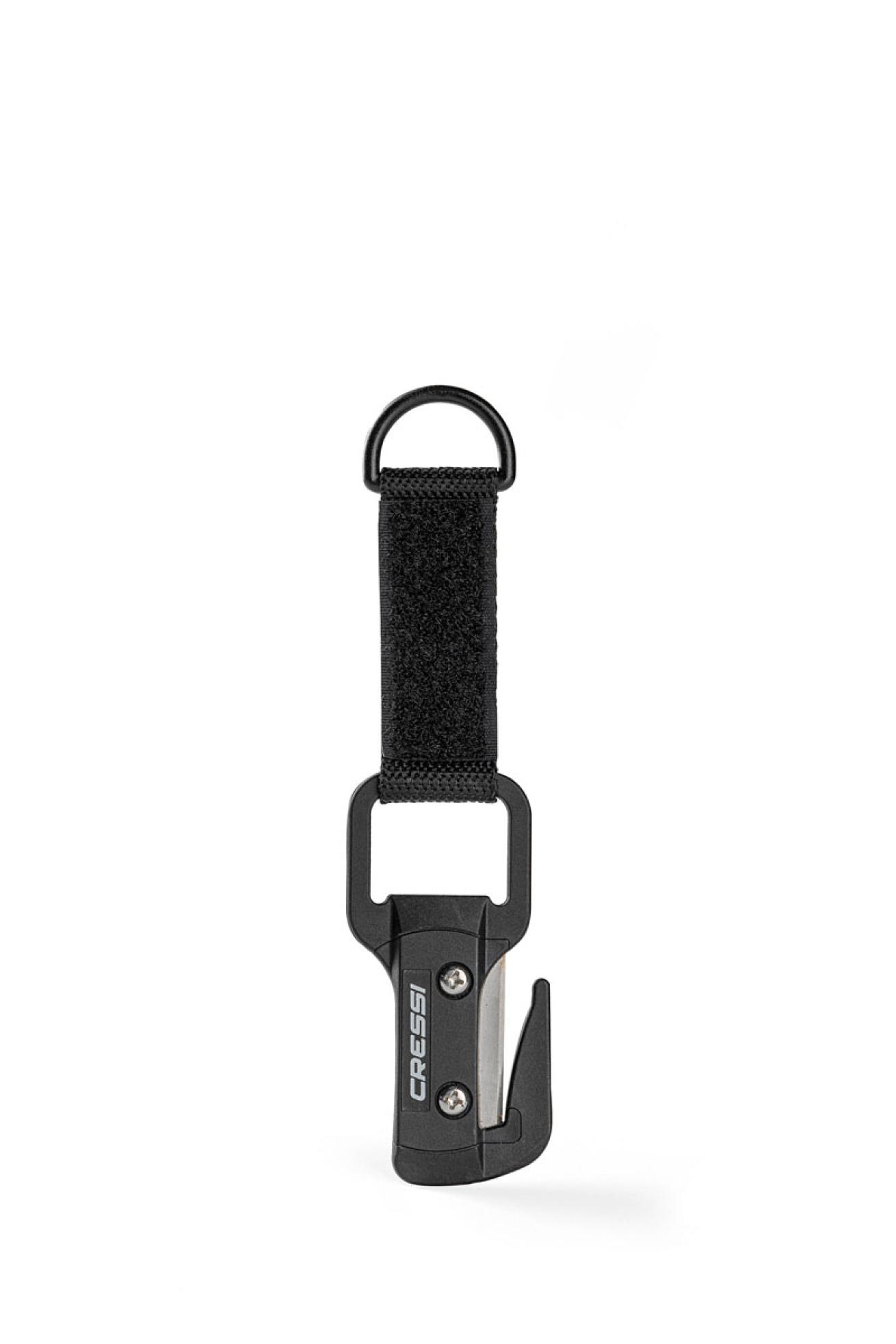
Jon WhittleMSRP $29.95 CONTACT cressi.com
Simple and compact, this single-blade line cutter is a quick way to free you or a buddy from small line tangles. In our test, it scored excellent almost across the board for its cutting ability. It zipped through monofilament and hollow poly, and while it struggled slightly with the larger, more fibrous manila, testers still rated it very good. In fact, we found it would cut pretty much any line that we could fit into it. The blade itself is a standard stainless razor; it cuts well, but also rusts readily. Two Phillips-head screws hold it inside the sturdy plastic casing and can easily be removed for cleaning or replacement. It scored good for security and ease of grip. While the D-ring handle is too small for two fingers and the strap is not very long, the cutter was scored good for security and ease of grip. Tucked in its nylon sheath and secured with Velcro, this line cutter can be mounted vertically or horizontally to webbing up to 2 inches, or 50 mm, wide for easy, quick access.
IST SPORTS CERAMIC LINE CUTTER
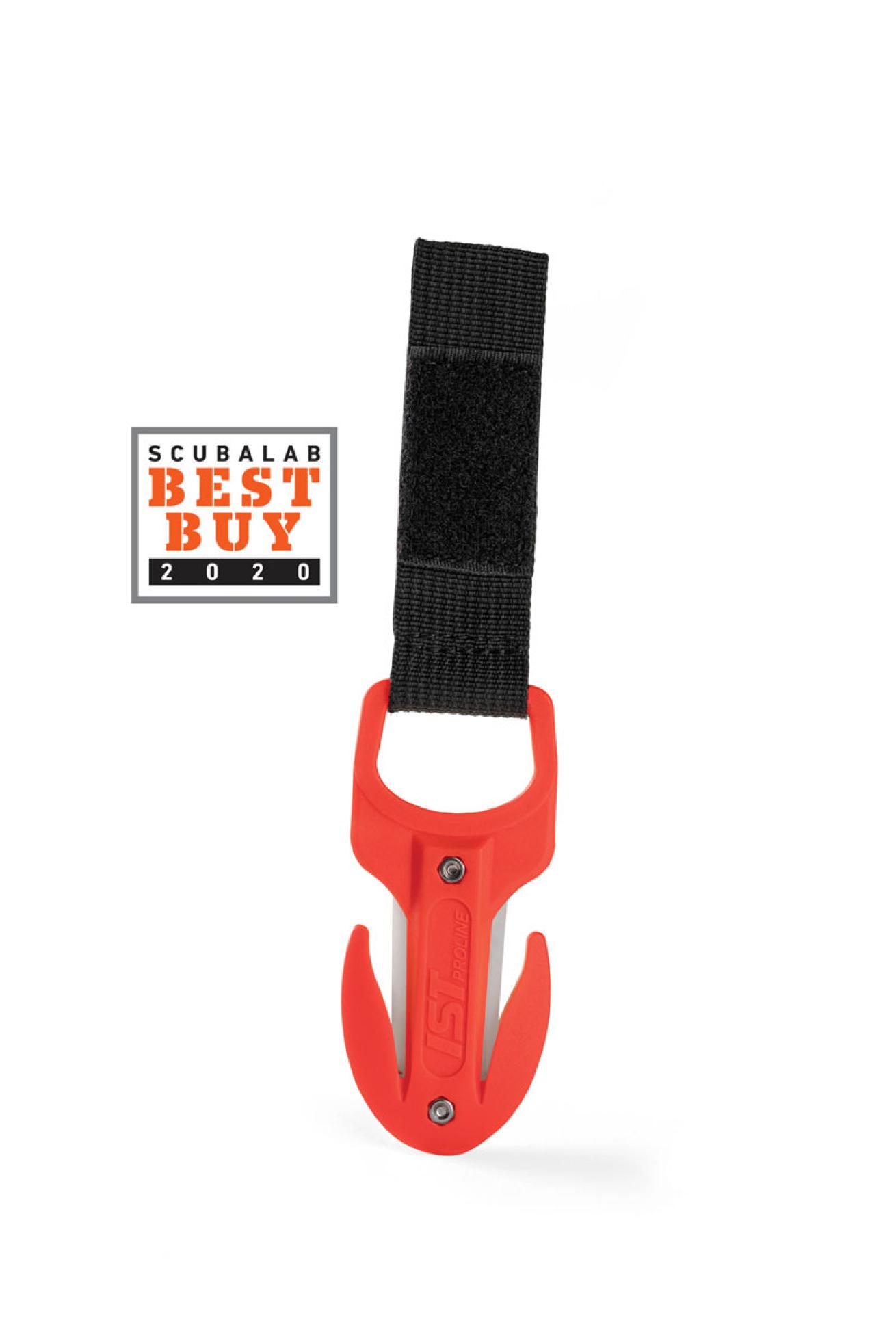
Jon WhittleMSRP $40 CONTACT istdivingsystem.com
It’s hard to imagine a more unassuming piece of dive gear than this little line cutter: ceramic blades sandwiched inside a two-piece polycarbonate body and held together with a pair of stainless screws. But while it won’t cut half-inch rope or impress anyone on the dive boat, it will make short work of most things that fit into its ¼-inch jaws. That goes for stuff it’s not really designed to cut, including—in our case—heavy zip ties and 4-wire telephone cable. The body of the cutter is heavy enough to feel like it won’t break with a hard pull, and the finger loop at the back is big enough to get a firm grip. Velcro on the sling holds it securely in the nylon sheath, which can be mounted vertically or horizontally and lets you deploy it with no fuss. But its biggest plus is that the blades won’t rust no matter how long it’s been sitting around in salt water. As one tester noted, “Nothing fancy here, but really gets the job done.” The ceramic line cutter is our Best Buy for cutting tools.
CRESSI ALLIGATOR
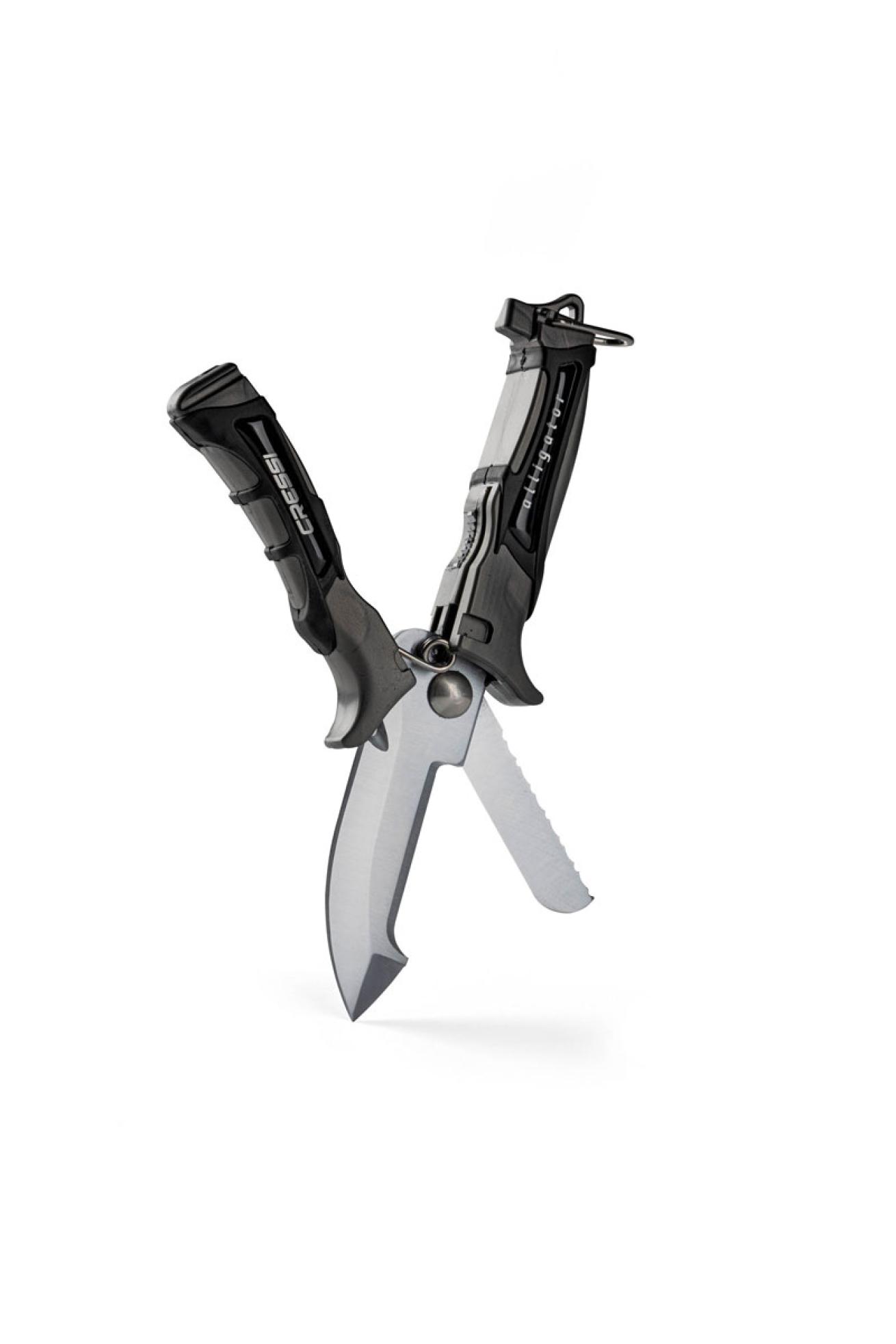
Jon WhittleMSRP $69.95 CONTACT cressi.com
With serrated and smooth edges, line cutter and spring-loaded shears, the Alligator is equipped for a variety of challenges. The over-molded handle provides a good grip, but unfortunately, its short size and simple latch make it too easy to accidentally open the scissors while cutting with the knife blade. “There are a lot of sharp parts waiting to bite you,” one tester observed. The shears “whiz through monofilament and manila, but choke on small fibers of the yellow poly,” one tester noted. Release tabs on the sheath are stubborn, requiring a bit more pressure than usual. This helped it score very good for security, but less so for ease of removing/replacement. The cutter must go into the sheath with the bolt facing down, which further complicated replacement. “A pain. Gets hung up,” one diver noted. The 420 stainless steel held up well in our corrosion test, helped by a generous coating of mineral oil that you’d do well to renew frequently.
IST SPORTS K25
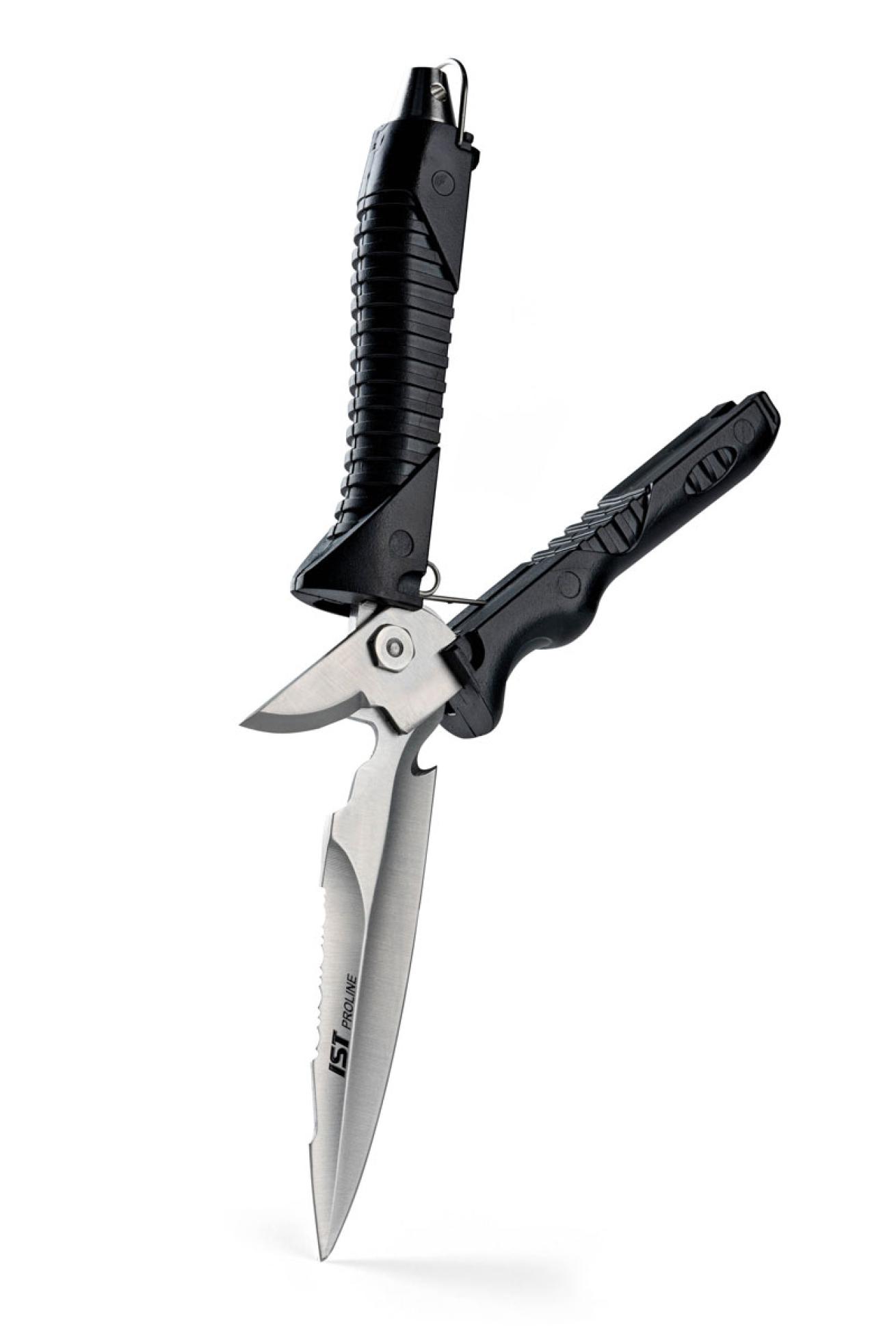
Jon WhittleMSRP $68 CONTACT istdivingsystem.com
The 6-inch knife blade is what first catches the eye, but it was the teeny tiny scissor that impressed testers. The shears earned excellent scores for cutting stiff monofilament and manila rope, snipping through each with a squeeze, though slowing on the mushier polylines. “Cutter bites into stiff line with gusto, but struggles with the softer stuff,” one tester observed. When the shears bogged, testers switched to the serrated edge. Though the shears’ locking mechanism is identical to some other cutters here, the longer grip kept it from opening accidentally during cutting. The K-25’s many stainless parts need careful washing to prevent corrosion. The sheath lets the cutter rattle a bit, but holds it securely (though you need to make sure it’s fully locked in). Despite the scissor’s sheer cutting power, the fine-tipped point and numerous moving cutting edges make this tool a little impractical for safely cutting lines around sensitive objects—i.e., you or your buddy.
OMS SK2 SCISSOR KNIFE
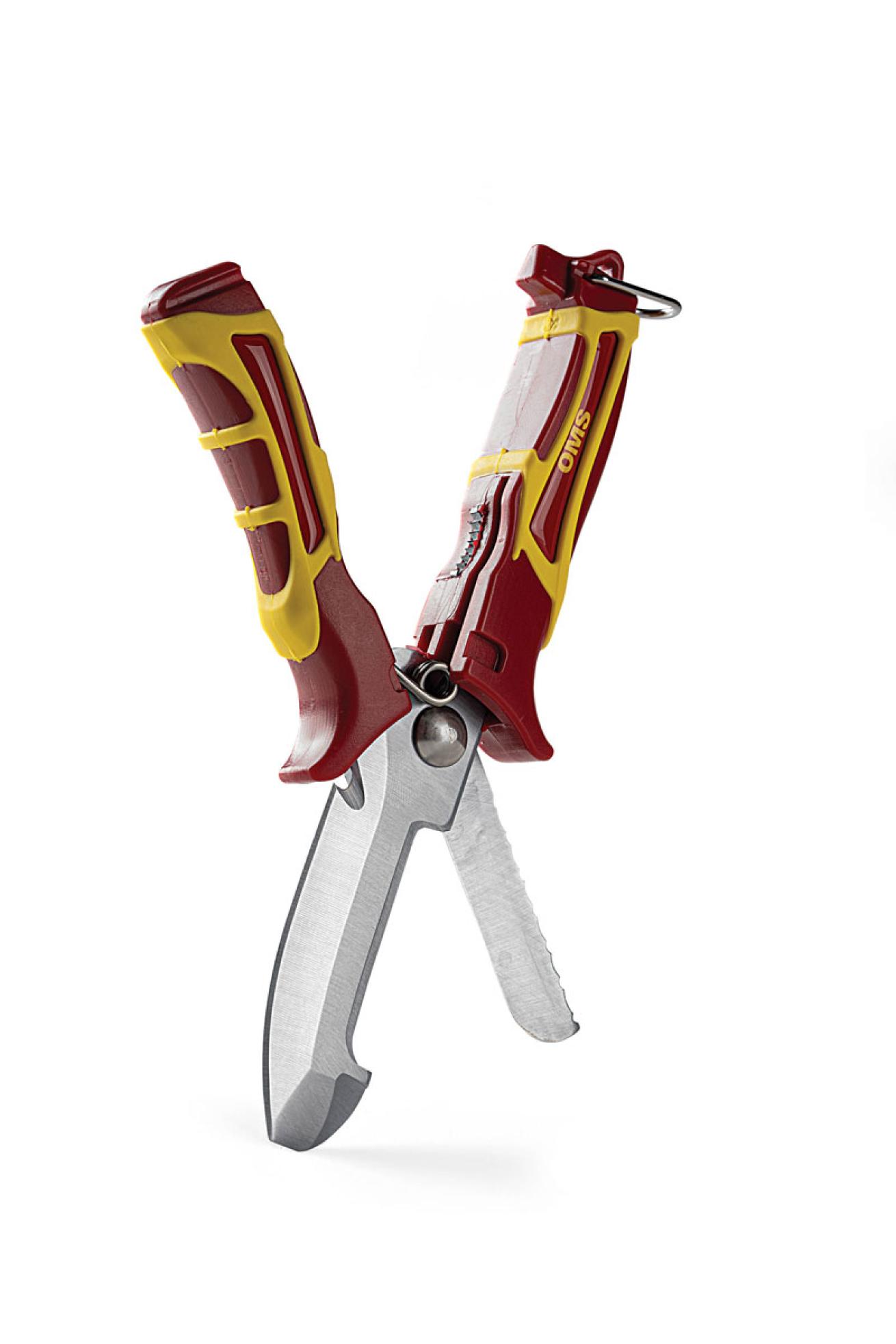
Jon WhittleMSRP $91 CONTACT divedui.com
The SK2 is another tool with options for dealing with entanglements. With plenty of leverage, the clippers scored excellent for ease of cutting through thick monofilament, powering through multiple strands at once. They also sliced through the manila rope with ease. The knife’s straight edge made short work of the hollow poly, prompting testers to score it very good. Though it took at least 12 passes, the serrated edge was able to saw through ½-inch twisted poly. Sturdy construction and a blunt tip allow the SK2 to pry with a generous amount of force. The locking mechanism that unleashes the spring-loaded scissors is simple to use—in fact, it’s a little too easy. “Handle often releases accidentally,” one tester complained. The little latch can also catch on the elastic band while removing the tool from the very secure sheath. The steel showed some mild discoloration inside the handles after a 24-hour saltwater bath, but was otherwise unblemished.
TEKNA OCEAN EDGE
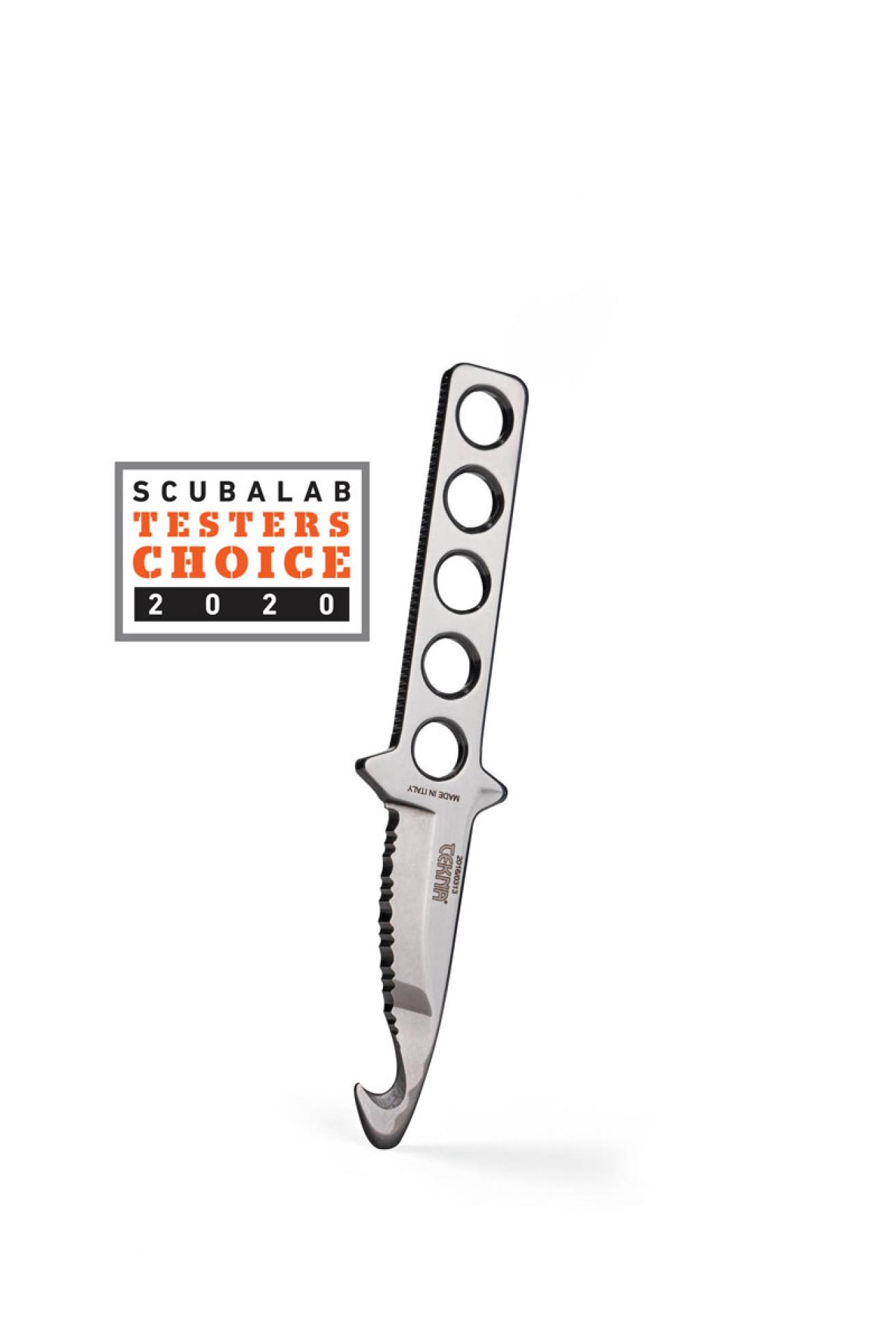
Jon WhittleMSRP $119.95 CONTACT tekna.us
The Ocean Edge is also available with a daggerlike blade, but our test sample had a blunt-tip “rescue hook” design. It’s made from a solid chunk of 420 stainless, often used for surgical tools; it’s hard but not brittle, and reasonably resistant to corrosion. The 2-inch serrated edge cuts aggressively, though its short length limits single-pass cutting ability. But what impressed us was its effectiveness in safely cutting even hard, thick lines wrapped around objects, including an arm or leg—something we passed on trying with most models here. The skeleton handle with knurled edges is hard but grippy, and makes this by far the easiest tool here to clean. After 24 hours in salt water, we found one small patch of rust inside a hole in the grip, which easily rubbed off. The hook tip makes it a chore to extract from its spring-lock sheath, but it won’t fall out. A reliable tool that can cut tangles without cutting you, the Ocean Edge was our Testers Choice for cutting tools.

